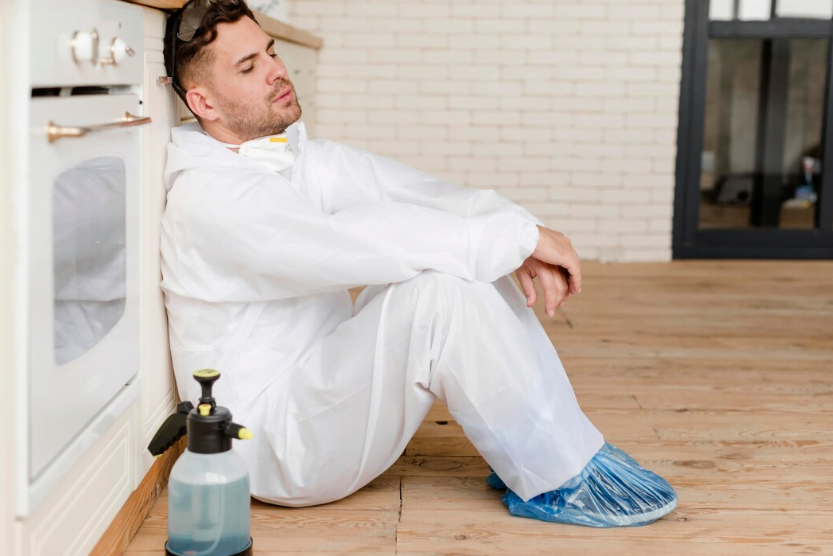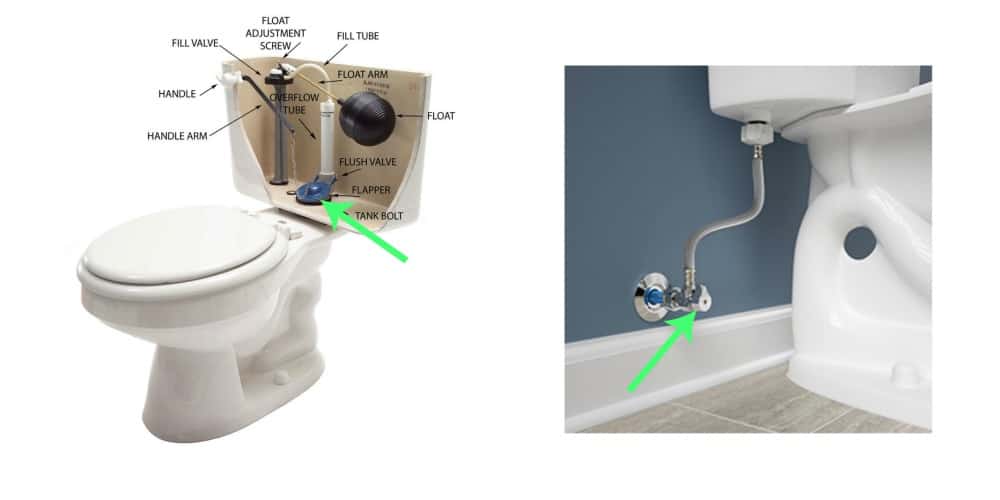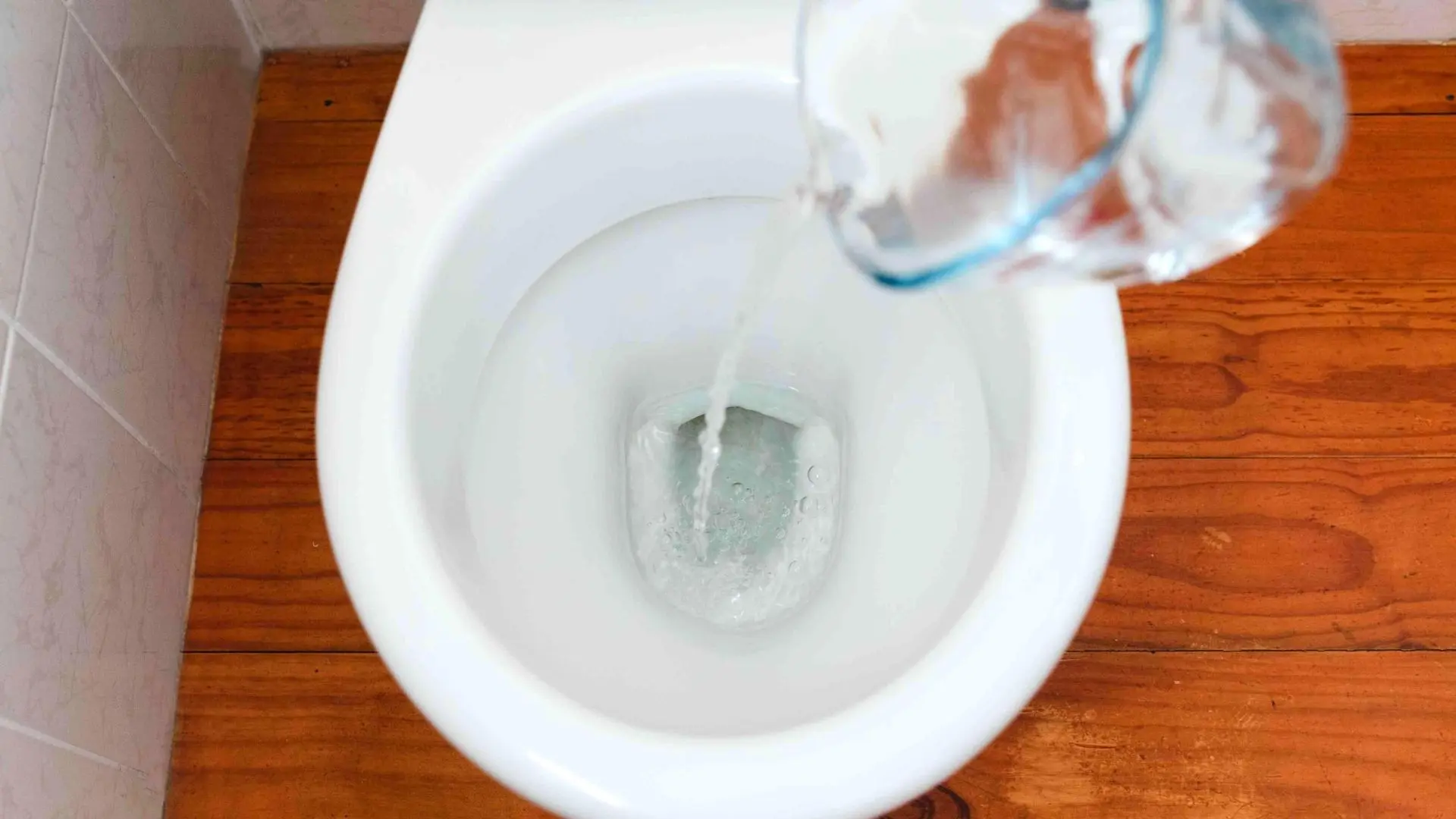How to Unclog a Toilet With Bleach, pour 2-3 cups into the bowl, wait 10 minutes, then flush. This method is typically used for minor clogs and should be done with caution.
Dealing with a clogged toilet can be one of the most frustrating household challenges. Everyone seeks a quick, efficient, and safe solution to restore their bathroom’s functionality. Bleach is a common household item that might prove effective in breaking down waste materials causing the clog.
It is important to note that bleach should only be used when dealing with organic blockages and should not be mixed with other cleaning agents to avoid hazardous chemical reactions. This method is simple, often does not require a plunger, and utilizes cleaning supplies you likely have on hand. Remember to provide the room with ample ventilation, since bleach fumes can be strong. Regular maintenance and careful use of your toilet can help prevent future clogs, ensuring your bathroom remains operational.

Introduction To Toilet Clogs
A clogged toilet is a hassle most homeowners experience. This common household problem can turn a routine day into a stressful one. Are you facing a stubborn clog? Understanding why clogs occur is the first step to fixing the problem. Read on to learn how bleach might just be the solution you need.
Understanding The Common Causes Of Toilet Clogs
Clogs in toilets can happen for various reasons. Some of the most frequent culprits include:
- Excessive toilet paper use: Too much paper can choke the pipeline.
- Non-flushable items: Wipes, tampons, and even cotton balls belong in the trash, not the toilet.
- Build-up in pipes: Over time, things like hair and soap can create blockages.
- Blocked plumbing vents: These help regulate pressure, and when blocked, can cause a clog.
- Hard water: It can lead to mineral deposit build-ups in your pipes, restricting flow.
Why Bleach Can Be An Effective Solution
Bleach is a powerful disinfectant known for killing germs and dissolving tough stains. It also works well for:
- Breaking down organic matter: This includes waste materials in the toilet.
- Disinfecting the area: Bleach eliminates bacteria that can grow in clogged toilets.
- Simplifying the process: Unlike plunging, pouring bleach requires less physical effort.
Ready to tackle that clog? Let’s move forward and learn how to unclog your toilet with bleach.
Safety First: Preparing To Use Bleach
Before tackling a clogged toilet with bleach, prioritize safety. Bleach is powerful and effective. Yet, it requires careful handling. Knowing the right safety measures is key. It protects you and your home.
The Importance Of Proper Ventilation When Using Bleach
Bleach emits fumes that can be harmful when inhaled. To safeguard your health, open windows and doors. This allows fresh air to circulate.
- Turn on exhaust fans if available
- Keep the door open while working
- Avoid using bleach in confined spaces
Protective Gear And Precautions For Using Chemicals
Dress for the task with suitable protective gear. Proper precautions reduce the risk of accidents.
- Wear gloves to shield hands from chemicals
- Eye protection stops splashes from reaching the eyes
- Long sleeves and pants prevent skin exposure
Read the label on the bleach bottle. Follow the instructions carefully. Never mix bleach with other chemicals. This can cause dangerous reactions.
Bleach Basics: Understanding The Chemical
Bleach Basics: Understanding the Chemical is essential before attempting to unclog a toilet. This common household cleaner is known for its potent disinfecting power. It’s crucial to handle with care. Bleach can work wonders on various messes and blockages. Knowing how it interacts with organic material is key to using it effectively and safely in your plumbing.
How Bleach Interacts With Organic Material
When bleach encounters organic substances, a reaction occurs. This reaction breaks down the compounds, allowing bleach to disinfect and clean. It’s this property that suggests its potential effectiveness in unclogging a toilet. Add bleach to the bowl and it begins breaking down organic matter, which may include toilet paper or waste causing the blockage.
The Pros And Cons Of Using Bleach For Plumbing Issues
The Pros:
- Effective Disinfectant: Kills germs and bacteria present in toilet blockages.
- Accessibility: Readily available and often already in the household.
- Breaks Down Waste: Can dissolve blockages caused by organic material.
The Cons:
- Corrosive Nature: May damage pipes if used frequently or in large quantities.
- Environmental Concerns: Harsh chemicals can be problematic for wastewater treatment.
- Safety Risks: Risk of harmful fumes, especially if mixed with other cleaners.
| Factor | Consideration |
|---|---|
| Concentration | Use a dilute solution to minimize pipe damage. |
| Frequency | Avoid regular use to protect plumbing and the environment. |
| Safety | Ensure proper ventilation and never mix with other chemicals. |
Step-by-step Guide: Unclogging A Toilet With Bleach
A clogged toilet is a nuisance we all want to avoid. Bleach can be an effective solution. It is a powerful disinfectant that helps break down waste. This guide dives into using bleach to clear that stubborn blockage.
Measuring The Appropriate Amount Of Bleach
Getting the right bleach amount is crucial. Too little may not unclog the toilet. Too much can harm your plumbing. Begin with a half cup of bleach. Read the bleach label for the best results.
The Waiting Period: How Long Should You Let The Bleach Sit?
Patience plays a key role in this process. Pour the bleach into the bowl. Let it sit for 10 minutes. This gives the bleach time to work on the clog. Do not flush immediately after pouring.
- Ensure you have adequate ventilation in the bathroom.
- Wear gloves to protect your hands from the bleach.
- Measure and pour the bleach into the toilet bowl.
- Allow it to sit and break down the clog for 10 minutes.
- After waiting, flush the toilet to clear the clog.
- If the clog persists, repeat the process or consider a plunger or snake.
Alternative Methods To Augment Bleach Effectiveness
When a stubborn clog takes over your toilet, bleach may be a go-to solution.
But sometimes, bleach needs a helping hand to work wonders.
Let’s explore alternative methods to make bleach even more effective.
Combining Hot Water With Bleach
Hot water boosts the power of bleach and speeds up the unclogging process.
- Boil a gallon of water but let it cool slightly before using.
- Pour half a cup of bleach into the toilet bowl.
- Carefully add the hot water to avoid splashing.
Wait for a few minutes. This combo can break down the clog.
Agitation Techniques To Speed Up The Unclogging Process
Agitation can help bleach work through the clog faster.
- Pump a toilet plunger to create movement.
- Use a toilet auger if the clog is unyielding.
These techniques help the bleach penetrate and dissolve the blockage.

Troubleshooting Common Issues During The Process
Troubleshooting Common Issues During the Process of unclogging a toilet with bleach can be straightforward. Yet, at times, stubborn clogs refuse to budge. This section tackles how to deal with such scenarios effectively.
What To Do If The Clog Persists After Bleach Treatment
- Wait – Give the bleach ample time to work, at least 30 minutes.
- Flush – After waiting, try flushing the toilet once.
- Plunger – If the first flush doesn’t help, use a plunger gently.
- Snake – A plumbing snake can break up deep clogs.
- Repeat – Sometimes a second bleach treatment is necessary.
- Professional Help – Persistent clogs might require a plumber.
Always wear gloves and open a window for ventilation. Avoid mixing bleach with other cleaning agents to prevent harmful fumes.
Addressing Potential Complications With Septic Systems
Septic systems need extra caution when using bleach:
- Use Mild Bleach – Opt for eco-friendly or septic-safe bleach options.
- Limited Use – Apply only in minimal amounts to avoid disrupting bacteria.
- Alternative Methods – Consider using a plunger or a snake first.
- Professional Advice – Consult a professional for products safe for your system.
Check manufacturer’s guidelines before adding any chemicals to your septic system to prevent damage.
Aftercare: What To Do Once The Clog Is Cleared
Aftercare: What to Do Once the Clog is Cleared––congratulations on successfully unclogging your toilet! But your work isn’t quite done yet. Proper aftercare ensures your toilet remains clean, hygienic, and clog-free. Let’s dive into the essential steps following the unclogging process.
Flush Strategy To Thoroughly Clear The Pipes
A flush strategy is important to remove any leftover debris. Here are some tips:
- Wait for the water to drain before the first flush.
- Flush once and let the water level stabilize.
- Observe the flush power to ensure it’s normal.
- Repeat if necessary, allowing water to fully drain each time.
Cleaning And Disinfecting The Toilet Post-unclog
Cleaning your toilet after unclogging is critical:
- Wear gloves to protect your hands.
- Prepare a bleach solution and apply it to the toilet bowl.
- Use a toilet brush to scrub thoroughly.
- Let the solution sit for a few minutes for disinfection.
- Flush the toilet again to rinse away the bleach and debris.
After these steps, ensure the space is ventilated to clear the fumes. Your toilet is now ready for regular use!
Preventive Measures To Avoid Future Clogs
Dealing with a toilet clog can be messy and frustrating. Preventive measures are key to avoiding this nuisance in the future.
Best Practices For Toilet Use And Maintenance
Keeping your toilet clear begins with smart use and regular upkeep.
- Only flush toilet paper and human waste.
- Avoid disposing of hygiene products down the toilet.
- Regularly check for leaks or slow drains for early detection.
- Clean your toilet bowl weekly with a brush and mild cleaner.
It’s also a good practice to educate family members, especially children, about what should not go into the toilet. Simple habits can maintain a clog-free bathroom.
Natural Alternatives To Chemicals For Routine Cleaning
Natural cleaners can be gentle yet effective for keeping toilets clog-free.
- Baking soda and vinegar can clear minor build-ups and freshen drains.
- Hot water flushes once a week help maintain clear pipes.
- Enzyme-based cleaners naturally break down waste materials.
Using these alternatives regularly prevents harsh chemicals from harming your plumbing. Your toilet stays clean and clear without the risk of corrosion or damage.
When To Call A Professional Plumber
Clearing a clogged toilet might sometimes need more than a plunger. At times, bleach alone can’t do the trick. It is important to know when to step back and call in the experts. A professional plumber has the right tools and expertise to handle complex clogs without risking damage to your plumbing.
Signs That The Clog Is Beyond A Diy Fix
- Water rises and overflows when you flush, showing a serious blockage.
- An unusual gurgling sound from nearby fixtures suggests wider pipe issues.
- Repeated clogs indicate deeper, stubborn blockages in your plumbing system.
- A bad odor persisting after several attempts may mean sewage backup.
- If using a plunger or bleach doesn’t clear the clog, this signals a serious issue.
The Benefits Of Professional Assessment And Intervention
Professional plumbers bring much to the table:
| Benefit | Description |
|---|---|
| Expertise | Plumbers pinpoint the exact cause of clogs efficiently. |
| Proper Tools | They use specialized tools that go beyond a typical plunger. |
| Safety | Professionals ensure the unclogging process is safe for your pipes. |
| Lasting Solutions | They provide long-term solutions preventing future issues. |
| Time-saving | Experts resolve the issue quickly, saving you time and effort. |
Recognizing when a clogged toilet is a job for the pros can save money and future headaches. Trust the signs and invest in a professional’s help for peace of mind. Bleach is a useful cleaner, but a plumber ensures a complete and safe resolution to your plumbing woes.
Environmental Considerations Of Using Bleach In Toilets
When a toilet clogs, reaching for bleach seems like a quick fix. But, this choice can affect our environment. It’s vital to understand potential impacts and explore safer methods.
The Impact Of Bleach On Local Ecosystems
Bleach can be harmful when it enters waterways. It contains chlorine, which can disrupt aquatic life. Here’s how bleach affects the environment:
- Chlorine transforms into toxic compounds, posing risks to fish and plants.
- Bleach can damage the beneficial bacteria in septic systems.
- Wildlife habitats may degrade, impacting biodiversity.
Small actions at home can lead to big changes in local ecosystems. We must be mindful of what goes down our toilets.
Eco-friendly Alternatives To Bleach
Luckily, there are safe ways to unclog toilets:
- Use hot water mixed with dish soap to break down clogs.
- Try a combination of baking soda and vinegar for a natural reaction that can clear pipes.
- Use a plunger or plumber’s snake to manually remove blockages.
These alternatives protect the environment while solving your plumbing woes. They keep your home and nature clean.
Faqs: Common Questions About Using Bleach In Toilets
Are you hesitant to use bleach to unclog your toilet? Let’s dive into some frequently asked questions about using bleach in toilets. This will guide you on how to do it effectively and safely.
Safe Quantities Of Bleach For Toilet Unclogging
Using the right amount of bleach is key to unclog your toilet. Stick to these guidelines:
- Half a cup to a full cup of bleach is safe.
- Use no more than 2-3 cups for severe clogs.
- Let the bleach sit for 10 minutes before flushing.
Can Bleach Damage Toilet Plumbing?
Concerned about your pipes? Mild use of bleach won’t harm your toilet plumbing. However:
| Usage | Impact |
|---|---|
| Occasional and in small amounts | Generally safe for pipes. |
| Frequent or in large quantities | Could damage the septic system and pipes over time. |
Ensure proper ventilation and avoid mixing bleach with other chemicals to prevent harmful fumes.
Conclusion: Summing Up The Bleach Unclogging Method
Understanding the bleach unclogging method is easy. This solution helps tackle pesky toilet clogs. With the right steps and precautions, anyone can do it.
A Recap Of Key Steps And Safety Measures
- Pour bleach: Use about 2 to 3 cups into the toilet bowl.
- Wait: Let it sit for 10 minutes.
- Flush: Check if the water runs smoothly.
- Repeat if needed: Sometimes a second try is necessary.
Safety is crucial. Use gloves. Don’t mix chemicals. Always have good ventilation.
Final Thoughts On Managing Toilet Clogs Effectively
Using bleach is simple, practical, and often effective. If the clog persists, consider other methods. A plunger or a plumber might be necessary. Remember, regular maintenance keeps toilets clog-free.

Frequently Asked Questions Of How To Unclog A Toilet With Bleach
Can Bleach Really Unclog A Toilet?
Yes, bleach can effectively unclog a toilet. It breaks down organic waste in clogged pipes. For best results, pour 2 to 3 cups of bleach into the bowl. Wait about 10 minutes for the bleach to work on the clog before flushing.
How Much Bleach Is Needed For Toilet Clogs?
For a standard clog, use 2 to 3 cups of bleach. This quantity is sufficient to break down the blockage without damaging the plumbing. It’s essential not to overuse it to prevent corrosion of the pipes.
What Safety Precautions Should I Take Using Bleach?
Always ensure the room is well-ventilated when using bleach. Wear gloves and avoid mixing with other cleaners, especially ammonia, as it creates toxic fumes. Keep bleach away from skin and eyes to prevent irritation.
How Long Should Bleach Sit In The Toilet?
After pouring bleach into the toilet bowl, let it sit for about 10-15 minutes. This allows it to penetrate and break down the clog. After waiting, attempt flushing to clear the pipes.
Conclusion
Clearing a stubborn blockage doesn’t require panic or a plumber’s help. With bleach, hot water, and patience, your toilet can be clog-free. Remember, safeguard your skin and eyes and provide ventilation. For those unavoidable clogs, this method offers a simple, chemical solution.
Ready for a pristine, fully functioning toilet? Bleach might just be your go-to fix!

